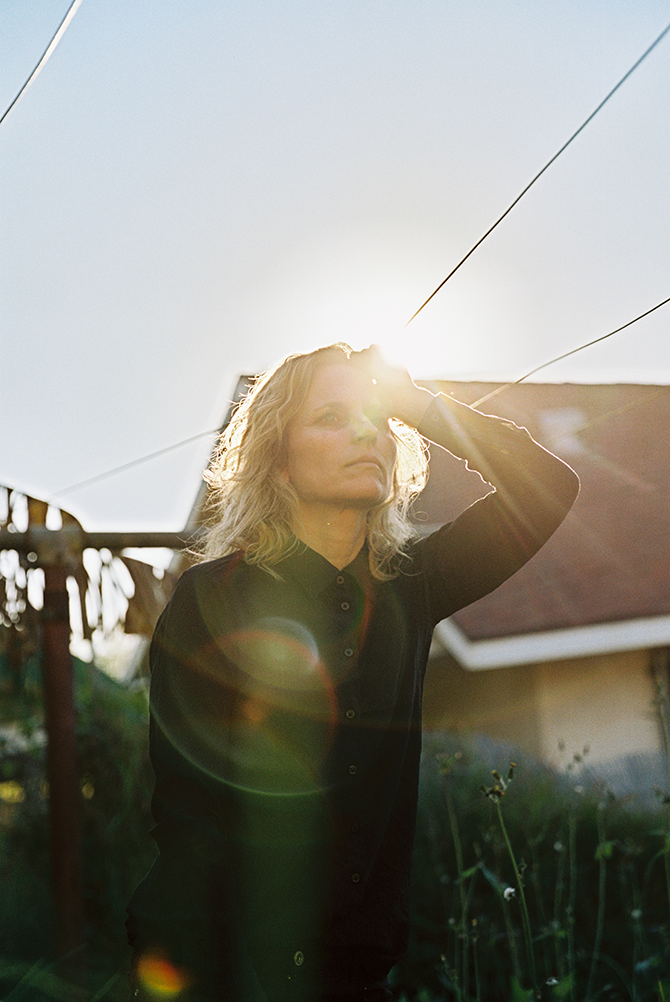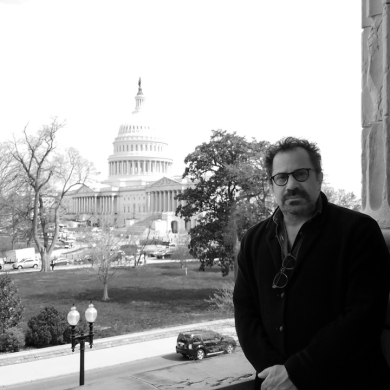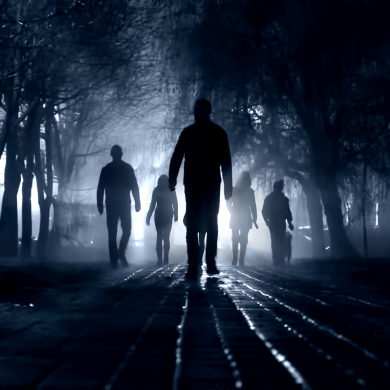Published Date: 01-26-22
Speaking to CreativeFuture from her studio in California, Morgan Doctor looks like she’s right at home.
Over her shoulders, hanging string lights illuminate a drum set and a couch, upon which her dachshund, Cymbal, quietly naps. An electric guitar leans against a wall lined with large panels of sound-dampening foam. This is not only the office of someone who works in music – it’s the office of someone who works very loudly.
Stepping back from the camera for a moment, Morgan sits at the drum set in the corner of her studio and starts to improvise a riff. “You’ll see that [Cymbal] doesn’t even move,” Morgan says.
And she’s right – Cymbal is barely roused by the sudden snap of toms and snares, perking up just a bit to listen. This is business as usual in the studio.
Though the drums are Morgan’s first calling, she has scored films, toured the country and the world, and explored countless corners of her creative ability. With CreativeFuture, she discussed the beginnings of her music career, her visual art, and the work that’s on her (and Cymbal’s) horizon.
JC TAYLOR: So, the last year and a half (plus) has been difficult for everyone. How was it working as an artist through a pandemic? Have you noticed your art change because of it?
MORGAN DOCTOR: For me, the biggest pivot I’ve made is to do more film scoring and to be able to work from home. I’ve also gotten into recording sound on documentary film sets. So yeah, I’ve just been learning to do more stuff that didn’t require live performance. Thanks to that, I’ve been able to be a bit more selective about the kind of gigs I want to take, whereas before I would try to take whatever came my way.
JT: So, let’s jump back for a second. I’m curious, what was it that first got you into music?
MD: I started playing drums when I was ten years old, and my parents insisted that if I wanted a drum set, I would have to take lessons. I remember sitting down with my music teacher back then and having no idea what was going on, but just trying to imitate what he was doing. From that point forward, I was always in bands and studying music.
I went to UC San Diego, and everyone really encouraged me to study something other than just music, so I could have a back-up plan. So I studied literature writing and minored in music. While I was there, I played in the school’s percussion ensemble, and I was also really involved in the local alternative scene, which was really thriving at the time. Every break from school I had, I spent touring with bands.
After school, I made a big career/life jump and moved to Toronto where, for the first time, I was a hired hand. I was doing studio sessions for other bands and learning other people’s drum parts and music – and getting paid for it.
The whole time I was performing music, I was also writing songs and learning music software. I have always had a deep interest in experimenting with every day “found” sounds and making new sounds out of acoustic instruments. I think that skill has really helped me when it comes to scoring for films and composing music for dance.
JT: When you made that “Big Leap” in your career, was that validating to the people in your life who said you needed a backup plan?
MD: You know, it’s interesting… The career of a musician has really changed a lot over time. When I was in an indie band as a college student, we were making a lot of money on the road. We were making enough money that we could buy a van and have bank accounts. We were really doing well for ourselves. I think that’s difficult to accomplish now with streaming and how the revenue models have evolved.
Was it validating? I’ve certainly had my validating moments, but I think it was one of my drum teachers who told me, “You have to be okay with riding in a limo one night, and taking the bus the next, because that’s how it is as a professional musician.” And that’s true. One day, we are wined and dined, playing amphitheaters for tens of thousands of people, and the next day we are carrying our own gear on our backs to a bar gig. I have always found ways to ensure my financial stability, but I also enjoy living simply.
JT: Are those big gigs worth the hardships you mention? I’m sure it’s an incredible feeling.
MD: It is an incredible feeling. I’ve had the chance to play some epic venues – Red Rocks, the Greek Amphitheater, Radio City Music Hall, David Letterman. At Radio City, they have this massive book in which all the performers who play there sign their names. Looking through it just blew my mind – all the iconic names that were written down in the same book as mine. That was a validating moment, for sure.
JT: What do you think it was about the drums specifically that you were drawn to?
MD: As a kid, I was a really active child. When I was growing up, there was this thing called the Presidential Physical Fitness Test in school, I was all over it. I even got a letter from President Reagan acknowledging my physical fitness. I think I liked the drums so much, because it’s so physical – it takes a lot of concentration and physicality.
JT: Do you find it more rewarding when you’re working in a collaborative environment, or when you’re working on your solo material?
MD: So often as a drummer, I’m helping someone else realize their vision, bringing my skills to aid them with that. As a drummer, I have to really be a team player. I like feeling like I’m part of team, so I find it very rewarding. However, when I’m working alone, there is a lot less pressure, and I feel freer to experiment with different sounds. Still, I prefer collaborating with other artists.
JT: I want to talk about the album you put out in 2019, Strangers. I was really struck by your “Write a letter to a stranger” initiative. Could you tell me a bit about what that is and what you hope to achieve with it?
MD: Strangers came out of my residency at the Banff Centre for the Arts. The Banff Centre is a magical place for artists – just being there made me feel a part of a massive lineage of artists that have been doing this for thousands of years. It was just incredible – both humbling and inspirational. They give you a basic hut in which to work and whatever supplies you need. I would just spend all day writing music in that hut in the middle of winter with deer outside, surrounded by snow.
It was in that environment the album was formulated. I was thinking about the idea that we’re all strangers in this world, and sometimes we come together and we have these intimate connections with each other – and then we fall apart again, and we are back to being strangers. We don’t talk to each other anymore. I was trying to capture this feeling of isolation and loneliness that can develop without actually being alone – like making connections while still feeling anonymous.
When I was planning to release the album, I conceived it to be more of an art installation rather than a live performance experience. People would go into a room in which music was playing, and they would be invited to write a love letter to a stranger and put it up on the wall. That idea evolved into us inviting everyone online to write love letters, and we began receiving these letters from all around the world. Now, we are designing a book that will be a photo collection with those letters.
JT: That must have been so exciting seeing so many people around the world connecting with your work.
MD: Yeah, it was! And many of them were very personal letters about what people were feeling, and what was going on in their inside lives. It was so interesting to see people connect with this project on that level.

JT: It’s amazing that you saw people connect with your album on that level – but, you’ve also scored films. What’s that process like compared to working on an album?
MD: Right now, I’m working on a film with director Ondi Timoner, and there’s this real back and forth where she describes what she wants the scene to feel like, and I write something. Then she’ll change the cut of the film, move things around, and send it back to me to write more. It actually feels like I’m making an album with someone else, like a visual album. It’s a very intensive process, but I think most art is that way.
JT: What do you think is important when it comes to maintaining a good creative relationship with the filmmaker when you’re composing the score to a film?
MD: I think with music, it’s helpful to have parameters. I want to know if there are certain instruments the director wants to hear or certain themes or feelings they want to come through in the score. I have to be on the same page with the director about what they are trying to communicate through the sound of the film.
JT: When you run into writer’s block, what do you look to for inspiration?
MD: Listening to other music helps for sure. I also find it helpful to just turn it over to someone you trust and let them contribute to a track. I feel like it gives me more tools to work with to collaborate.
JT: So, what are you working on now, and what are you looking forward to?
MD: I’m working on two of Ondi Timoner’s films that are very different – one is about the fast meme-driven disruption of finance, and the other is a very personal story about the right to die as experienced through the eyes of the director who is experiencing that process with her father. So, two very different ideas.
The latter film is heading to Sundance. So, it’s a lot of death, and the ethereal journey we take as we witness this transition, in my compositions right now. Aside from those, I have this live gig set drumming with the Woman’s Blues Review in Toronto in November, which I’m looking forward to.
JT: What advice would you give to someone just starting out in the creative industries?
MD: I think in any creative industry, it’s good to wear different hats and develop one’s work in different capacities. If I was just a drummer, or just a jazz drummer, I’d be really limited in what I could do and what I could be. So, for any artist, I would recommend diversifying your skills and being able to do more than just one thing. Not only is that good for your job security, but creatively I think it helps to keep you inspired.



